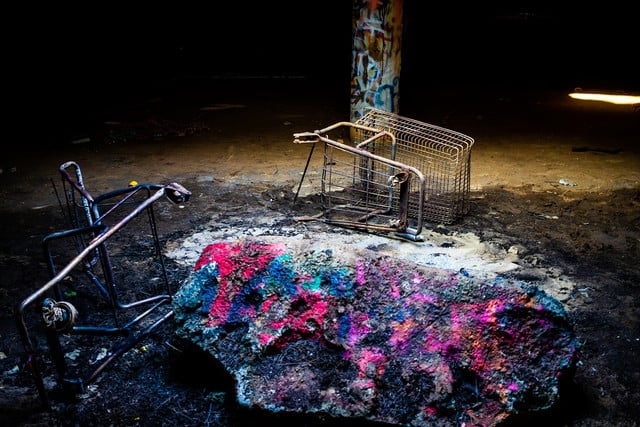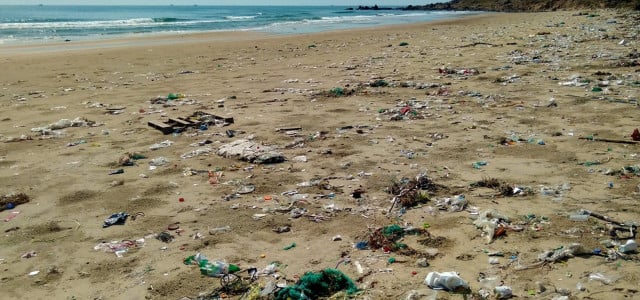Plastiglomerate is a brand new type of rock formation that marks the global plastic crisis. Should we be concerned? Find out more by reading what we know so far.
Plastiglomerate is technically not a rock because rocks are formed naturally. It is instead a combination of organic rock and plastic debris. For centuries, humans have been learning about our past by studying rocks. Future generations might just find traces of our current plastic pollution catastrophe until the end of time as it is now woven into every corner of the planet. Should we care? Let’s take a look at what we know to date.
What Is Plastiglomerate?

(Foto: CC0 / Pixabay / ChristinaZetterberg)
Pieces of plastiglomerate are accumulations of natural substances — like sand, shells, lava fragments, wood and rock — bound together by plastic. It was first discovered in 2012, when a geologist named Patricia Corcoran and colleagues went to Kimilo Beach in Hawaii to investigate and study it after claims of the unusual phenomenon appeared.
The beach was covered in these new formations and Corcoran initially suspected that nearby volcanoes had contributed to their formation. Sadly, plastiglomerate turned out to be just another example of the evolution of our plastic crisis. The new formations were actually a result of bonfires and litter. The beach was commonly used for camp and bonfires, and was so littered with plastic debris that it was impossible to make a fire without burning some.
Plastiglomerate in the "Anthropocene"



(Foto: CC0 / Pixabay / martypics)
Following this, Kelly Jazvac — an artist and one of Corcoran’s colleagues — showed the plastiglomerate in art exhibitions to demonstrate the impact humans have had on the planet. The hybrid rock formations are presented as both sculptural art and scientific artifacts that represent our current geological era —often called the Anthropocene, the “epoch of the human”.
This era represents a time of human dominance over the climate and environment. Plastiglomerate may well mean that we will be forever ingrained into the Earth’s geological history as destroyers. A popular theory is that the Anthropocene began with the Industrial Revolution of the 1800s — when we began pumping carbon and methane into Earth’s atmosphere. It also saw nuclear bombs and disasters — and unfortunately, the era continues into today.
The Plastic Catastrophe
We wanted a durable, flexible, shock-resistant, water-resistant substance, and we got one. Plastic is virtually indestructible and we use it for just about everything. Each year, eight million tons of plastic waste enters the world’s oceans and the amount that ends up in landfills in the U.S. every year has risen to 27 million. And there it stays until it becomes entangled with the natural matrix of our planet.
Plastiglomerate is just one member of a threatening new wave of unusual formations and compounds we know little about:
- Plastitar is a newly discovered marine toxin consists of tar balls — usually found after oil spills — and microplastics. It was discovered by researchers carrying out a study last year in the European Canary Islands.
- Pyroplastics are melted plastics that adopt the appearance of small rock. They were found floating around the coast of the United Kingdom and may be hiding in plain sight all over the world. These pyroplastics have been recently found to be an integral part of plastiglomerate formation.
- Nanoplastics are the tiniest plastic particles that have now infiltrated every natural environment — from oceans to dry land in every corner of the globe. Research is ongoing to determine if these minute particles can enter human cells and disrupt normal cellular activity.
Plastic Recycling



(Foto: CC0 / Pixabay / stux)
Some plastics can be recycled but many are contaminated by things like food, industrial and hospital waste. The US government claims to be committed to working with other nations to fight plastic pollution with various key programs to address the crisis. Some popular types of plastics, however, are nearly unrecyclable. For instance, black plastics are almost impossible to recycle.
Researchers all over the world are also looking at ecofriendly solutions — like microorganisms, enzymes, earthworms and insects — to break down plastics. Recent research in Europe is showing positive results using a combination of different organisms, like insects, earthworms and microbes, to convert non-recyclable plastic waste into biodegradable substances or to remove them from the soil completely. Scientists have even discovered plastic eating caterpillars.
Mushrooms are also attracting interest as they can be grown from a variety of contaminants — like biological wastes, agricultural wastes and industrial wastes. Plastic eating mushrooms might just be one natural way to clean up the crisis. You too can go plastic-free in 7 easy steps to make a difference.
Read more:
- Plastic Packaging that Makes You Question Humanity
- Can You Recycle Plastic Bags? – Recycling Tips
- Plastic-Free Shopping: 3 Easy Tips for Waste Reduction
Do you like this post?








